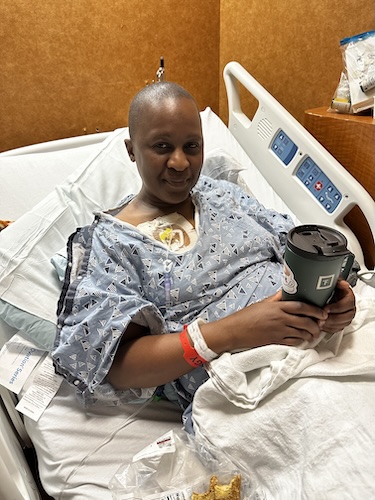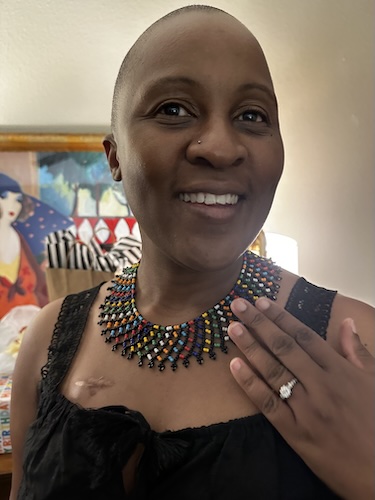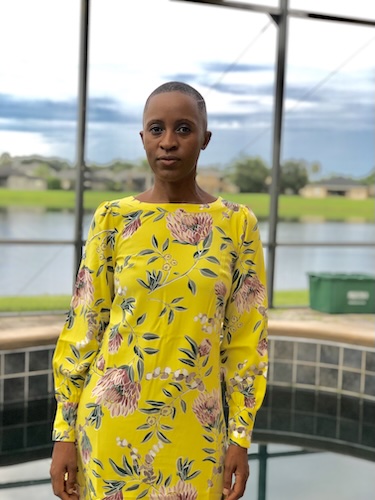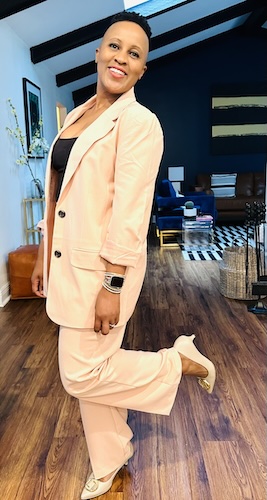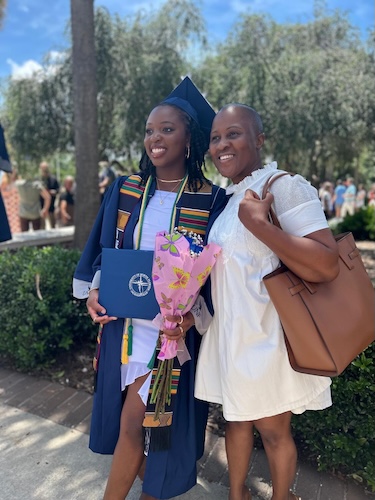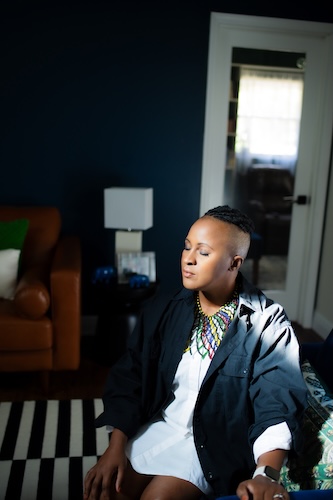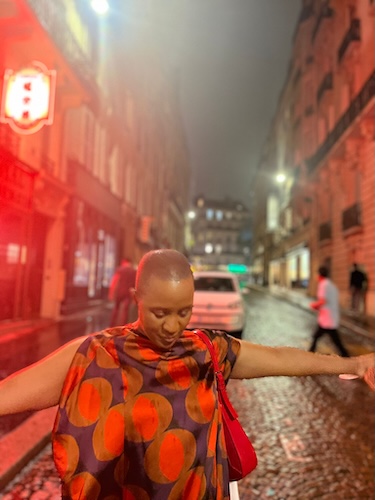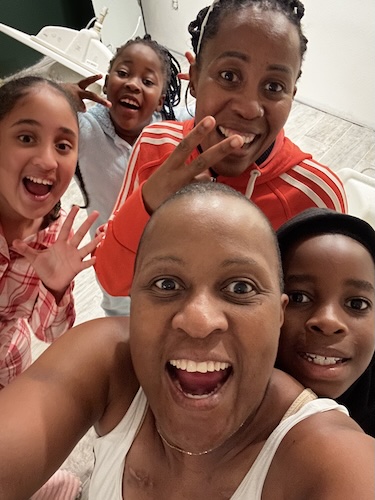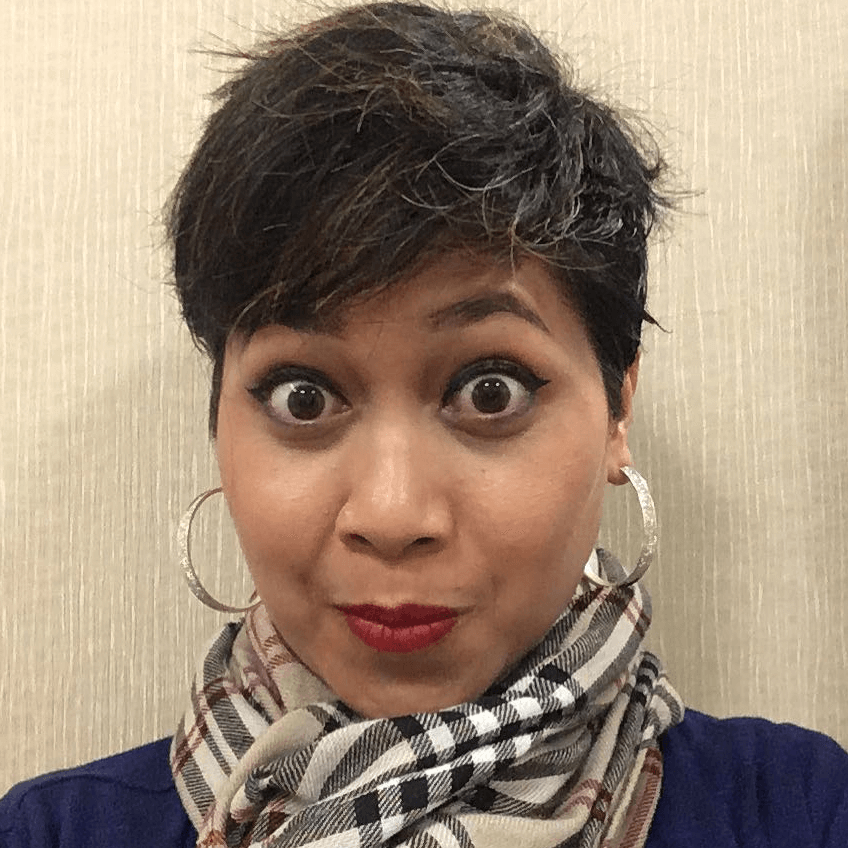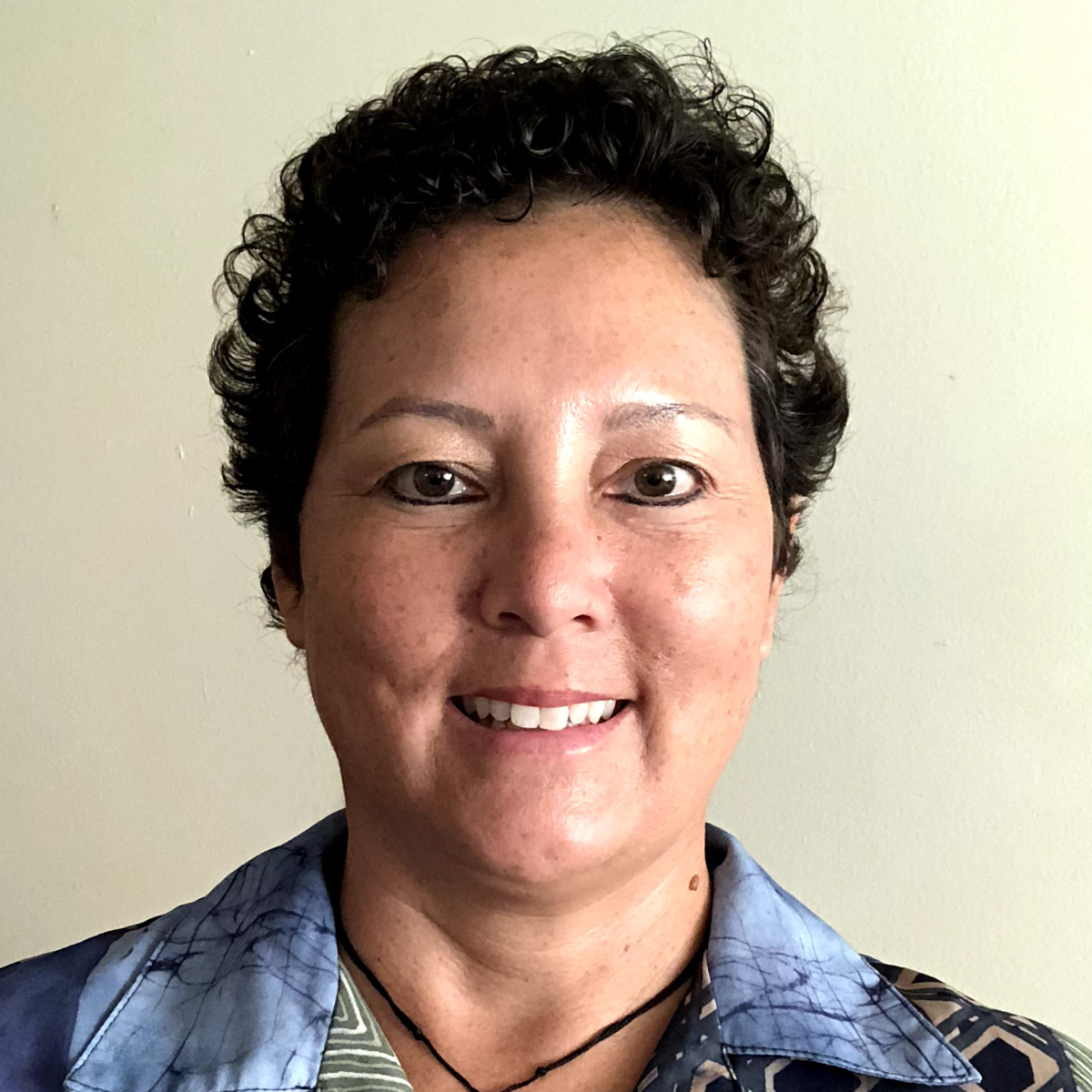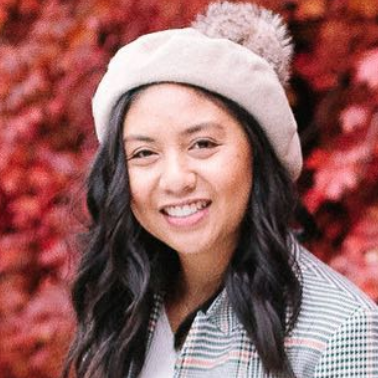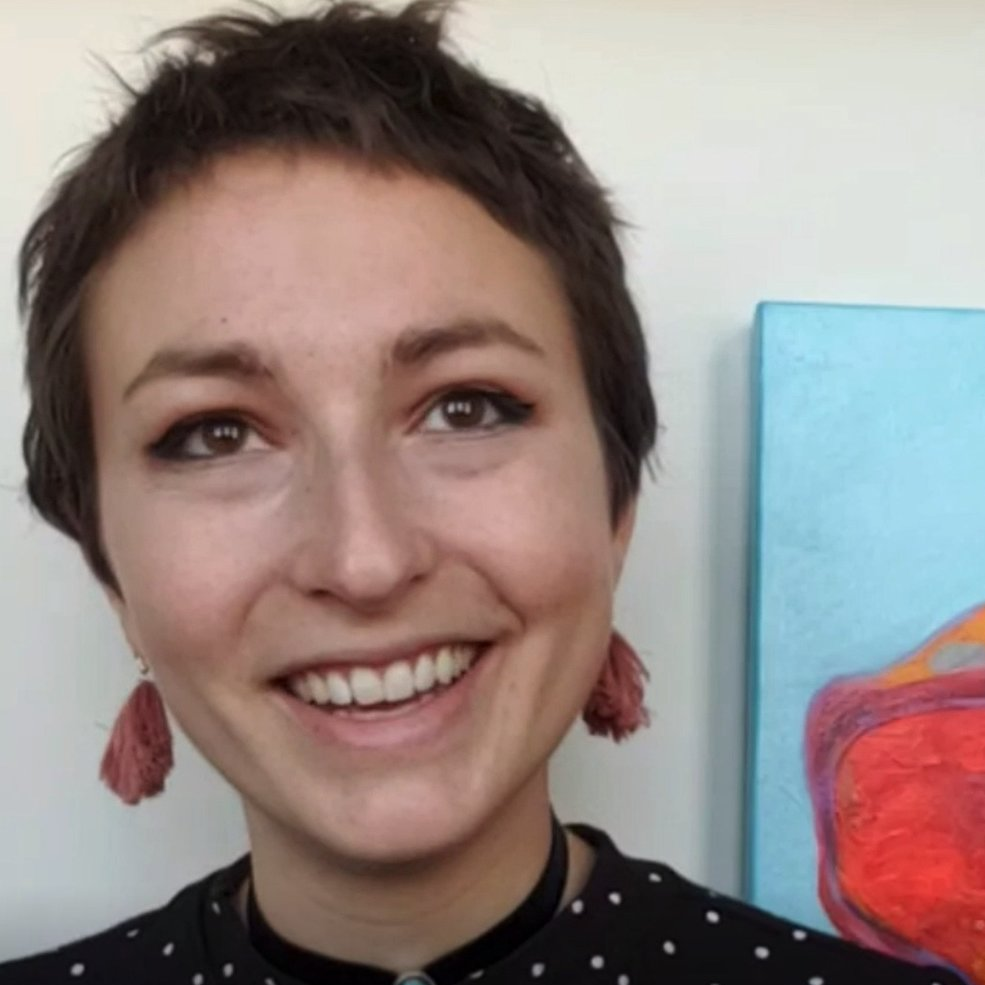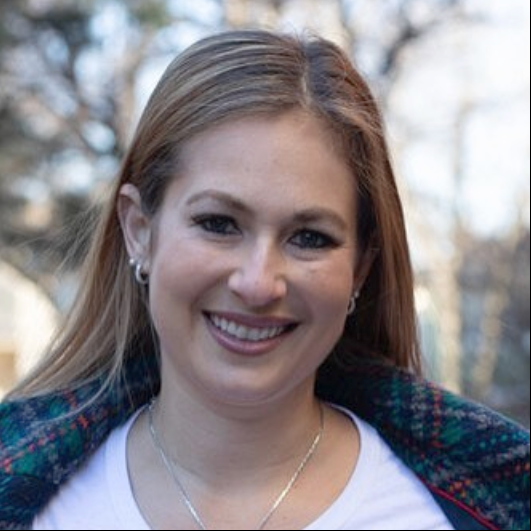“Know Your ‘Why’”: Dalitso Embraces Life Through Stage 4 HER2+ IDC Breast Cancer
Dalitso was diagnosed at 38 with stage 4 breast cancer. Eight years before her diagnosis, she noticed an unusual fatty lump in her left breast. Even after mammograms, the doctors she saw weren’t initially alarmed. In the succeeding years, she experienced fibromyalgia pain, weight loss, spasms, and eventually had a spinal fracture that revealed not only that she had breast cancer but that it had spread to her bones.
Interviewed by: Carly Knowlton
Edited by: Chris Sanchez
Dalitso’s life changed drastically in 2020. She had radiation and long-term treatments, including a combination of oral and injected medications. While these treatments were ultimately effective against her HER2-positive and invasive ductal carcinoma (IDC) breast cancer, they brought intense side effects, including neutropenia, anemia, heart issues, and overwhelming fatigue. She spent many days in the hospital, yet she embraced moments of connection, like cuddling with her children in the hospital bed. Eventually, the treatments led her to hospice care for palliative support, where she faced some of her most challenging days.
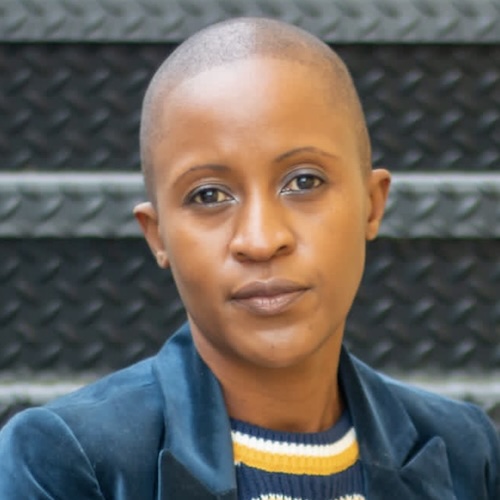
Despite these hardships, Dalitso found reasons to keep moving forward. She leaned on her faith and her family for strength. Even small projects, like planning home designs, gave her a sense of purpose. Her love for travel never faded; she managed to visit Paris, albeit in a wheelchair, and returned to her home country, Malawi. These were experiences she once thought were impossible.
Dalitso’s perspective on life has evolved into one of gratitude and authenticity. She focuses on “doing life,” raising her kids, being there for her mom, and staying connected with friends. She still manages the physical pain and continues ongoing treatments, but celebrates milestones like graduations and opens the memory boxes she once filled with letters and gifts for future moments she feared she wouldn’t see.
Dalitso’s story is a reminder that living with metastatic breast cancer is not just about treatment. It’s about finding meaning and purpose and celebrating small joys each and every day. She encourages others to know their ‘why,’ their reason to live and persevere; to stay connected to loved ones; and to embrace life with honesty and hope.
Watch Dalitso’s video and check out the transcript of her interview below. You’ll find out more about her experience:
- How her journey reveals the power of resilience, from a missed diagnosis to stage 4 breast cancer
- The way faith and family kept Dalitso going through pain and uncertainty
- How a mother’s love fuels her struggle against metastatic breast cancer
- The experiences, including travel and small joys, that brought hope in Dalitso’s darkest moments
- How knowing your ‘why’ can change everything in a cancer experience
- Name: Dalitso N.
- Diagnosis:
- HER2+ IDC (Invasive Ductal Carcinoma) Breast Cancer
- Age at Diagnosis:
- 38
- Staging:
- Stage 4
- Symptoms:
- Appearance of large tumor in left breast
- Severe back and body pain
- Treatments:
- Surgery: hysterectomy
- Vertebroplasty
- Radiation therapy
- Hormone therapy
- Clinical trial
This interview has been edited for clarity and length. This is not medical advice. Please consult with your healthcare provider to make informed treatment decisions.
The views and opinions expressed in this interview do not necessarily reflect those of The Patient Story.
- Hi. My name is Dalitso
- Eight years before my diagnosis, I noticed fatty tissue
- I had a second mammogram, and it revealed breast cancer
- When I heard I had stage 4 breast cancer
- I started radiation
- I was experiencing side effects from radiation
- I started hormone therapy
- I went on hospice
- I wanted to travel
- My cancer spread
- I started a new treatment plan
- I was declared No Evidence of Disease
- How my diagnosis has affected me being a mother
- I look at life differently now
- What I want others to know
Hi. My name is Dalitso
I was diagnosed with invasive ductal carcinoma in 2020 at the age of 38.
I am most passionate about people. I was a mental health therapist before I retired due to my cancer diagnosis. In our house, three generations live together. When it comes to fun, for me, it’s everything that revolves around going to the beach together, swimming, cooking, and traveling together. There’s always food at my house. I used to travel a lot before I got ill. That’s always a goal.
Eight years before my diagnosis, I noticed fatty tissue
It started with this fatty tumor tissue that I had eight years before my breast cancer diagnosis. Even after I had a mammogram, the doctors didn’t seem too concerned. It was getting harder and harder, like a golf ball. Then I started having fibromyalgia pains for years, and I was doing everything I could, like CrossFit and various other activities, to get my health back on track.
Come 2018, I started working with my doctor because I had a history of autoimmune Hashimoto’s. So we thought it was coming from that. So we really went strong, and we were dealing with that. But I lost a tremendous amount of weight. And so it really was very unsightly. Half of my breast was sticking out at the time.
By 2020, I was feeling a lot better. I had more energy. But I had back pain, and I was seeing a chiropractor. I was getting a lot of massages, but I just kept having these spasms.
I had a second mammogram, and it revealed breast cancer
I was getting off the examination table, and I was wincing because getting up my back was sore. And he looked very concerned, and I went, “You’re a breast surgeon. Why are we focusing on my back?” And he just looked very concerned.
The following day, he called me after an emergency PET scan and told me that it was actually stage 4. It had metastasized to my bones. And I actually was walking around with a fracture on my spine. That changed the course of treatment.
When I heard I had stage 4 breast cancer
I remember that day very well. I was newly divorced in 2018. My youngest daughter would spend one week with me and one week with her dad. She had just come back, and we were just sitting on the couch after I came back from work, and we were trying to figure out what kind of movie we were going to watch. And that’s when the doctor calls me and tells me the news.
And I was just shocked. And I still didn’t really quite comprehend what stage 4 meant. I think I was more shocked that I had a fracture in my back that prevented me from wearing the shoes that I love. I just thought, “Okay, it’s a higher level of staging.” In my mind, it wasn’t like, “Hey, this thing is going to kill you,” or “This thing is terminal.” It didn’t really hit me. I just said, “Okay,” and went on to watch a movie with my kids. I think it slowly hit me as we went along.
I started radiation
I was supposed to go and have palliative radiation on the fracture in my spine, not even on the breast. I did have a couple of hotspots, but the fracture was really causing pain and all that. I was also going to go in and start chemo with the oncologist.
But on my way there, the bone actually fractured all the way through. I was in the infusion center, but I was completely paralyzed from the belly down. They had to bring me to another place around the corner in an ambulance, where they did an emergency procedure that involved an epidural needle and injected a sort of liquid cement into the fracture in my spine. It was high intensity, short duration. No one could drive me. I had to drive myself, and I had 20 minutes after the procedure to get home and eat, and then I would just be wiped out and fall asleep.
After that, we started working with the oncologist. There’s no end to treatment when it comes to stage 4 cancer. It’s a matter of two things: how well you’re tolerating it, and how well the cancer is responding to it. My treatment was a newer drug combination that came out a couple of years ago for metastatic breast cancer. It worked really well on the cancer, but I had a hard time with it. One of the two drugs was injected, and the other one was ingested, through pills. On the first day of my pill, that’s also when I went in to get my shot. And that day, and every time I would go in, I’d stop breathing, and so it would become this emergency requiring Benadryl and steroids. We tried different combinations. Two nurses would do this and do that. Sure, the cancer was responding to it, but then I was developing all the other side effects.
I was experiencing side effects from radiation
The radiation was going into my bone marrow. My blood cells were becoming distorted, I was having heart issues for which I ended up in a hospital, as I mentioned, I also couldn’t breathe, and then, yes, neutropenia. I really started to feel them as the weeks went on. All this is not-so-fun stuff. Every six weeks, I ended up in the hospital.
Whenever I’m there, my kids always come and we cuddle on the bed together, literally squeeze into the bed together, and sometimes nap for as long as they allow us to. So that’s something we always do when I end up in the hospital.
I started hormone therapy
What I took is considered adrenal hormone therapy. The medications are working on disrupting the cancer’s attachment to the hormone. I did that until I started to need to get hospitalized constantly.
The cancer had already caused so much inflammation. Not only did I have the localized pain where the fracture had happened, but I was also constantly in physical pain. It was like the worst kind of flu, or like someone running me over with a dump truck.
So by August, we were trying different things. We tried certain pain medications. We tried changing to other medications. It was the same situation. We took a break from the medications in October. But I was still ending up in the hospital every so often. My white blood counts were tanking. The radiation had caused effects on the red blood counts, too. I was constantly anemic. So there were all these side effects that I was dealing with. We kept delaying it until the following year, 2020, on the first of April. And we tried one more time. And immediately, I was sick again, and it just spiraled. So in August 2021, I ended up in hospice.
I went on hospice
So we had to invite hospice palliative. They tried very hard, but I just kept going downhill to a point in 2021. I was saying goodbye to the kids. I was calling the kids’ schools and saying goodbye to friends. It was really bad. I just remember this one week where it was like living moment to moment, and it was just a vigil. My mother was not sleeping. It was a very, very challenging week. And so they were throwing everything at it right to a point where they threw too much at it.
And one of the doctors just listened to me, and he was like, “You need to be on hospice.” And I was trying to tell my doctor that. And he sent me to a psychiatrist and told my pain management doctor to stop giving me medicine because he said I was just pretending. Which was very upsetting.
I didn’t think I would make it. But by the grace of God, I did. I started pulling through.
I was in hospice for three years. We were struggling with the inflammation that was in my body, caused by the cancer and the treatment that we had. They just were having a hard time, and hospice was having a hard time. You know you’re in trouble because they have the liberty to give you as many things as they can at one point. For nine months, I was walking, sleeping, eating 24-7 with the big IV bag, the 500ml.
There were just days when you just couldn’t predict how you were going to feel. There were days when 4 or 5 nurses were being called to the house, just to come and manage the pain, because it just was not manageable. So I was mostly home, and I barely went anywhere. Because I couldn’t drive. It’s like Groundhog Day, where every day is the same. And if it weren’t for my children and my faith and having my mother with me, I don’t think I would be here right now.
Little things matter. Your perception matters, right? So for me, just having a project, like designing a house, gave me something to do that I didn’t need to leave the house to do.
I wanted to travel
There was a picture where I was sitting, it looked like on the patio, where I was just 85 pounds. I wasn’t a big person to begin with, I’m 5’1”. But I definitely wasn’t 85 pounds when I started this whole affair. It’s like all you could see was my head.
I had such a goal, though. I wanted to travel. I had promised to take my oldest daughter to Paris when she graduated from high school. I couldn’t do it. But my ex-husband surprised us both by taking us to Paris.
I was in a wheelchair for most of the trip. But it was still worth it. My ex-husband was just really amazing, and so were the girls. And we did everything.
I also really wanted to travel back to my home country, Malawi. I never thought I would make it back there alive. It was a big thing. My doctor was so encouraging. He went, “You can do it.” We did everything we could for me to take a five-week-long trip to Malawi, which was just so surreal. I remember landing back at the airport. I just wept, because I thought I was going to go back in a cremation box. So being able to come back alive was the best feeling.
My cancer spread
I was beginning to have some pain that just didn’t feel quite right. So I tried to get off the medication. That was horrendous, but I was able to feel that something was wrong.
So I went back to see my oncologist, and the cancer had spread. Some of my ribs and my sternum were broken. The cancer had spread into the ball sockets of my hips. I had extra fractures in my spine. So that’s what was causing the pain. So at that point, that was actually more challenging. Hearing that than the first time around.
My kids lost it. They did not want to hear about treatment because treatment is what brought me to palliative care.
I didn’t want to go back on treatment because I had vowed that I would rather just live my life instead of going back on treatment. I told my kids, “I wish mommy was able to do a lot of things, but I can’t decide where the cancer spreads.” Right? So that was more devastating. I was scared this time.
I started a new treatment plan
The doctor was going to put me on this new trial in which participants have had fewer side effects. It was already a phase two trial. The first thing I needed to do was to do radiation on the spots. I had no pain in my ribs and my left hand side, where the ball socket was very necrotic, and other places on my back. So we did that again. It was more intense than the last time. I just started not feeling well. I was swelling. I had blood clots. I had pneumonia for four months. So finally they had to they had to take me off that drug. And I’ve been doing relatively well since then.
I was declared No Evidence of Disease
My sister comes in, and I said, “Hey, what’s going on with the CT scan?” And she was like, “Oh, I didn’t tell you. The doctor wanted you to know that there’s no evidence of disease.” I’m like, “Wait, what does that mean?” “We don’t see anything. You’re good.”
It was such a surreal moment. Amazing. But I still struggle. Because I’m still in a lot of pain. So that’s sometimes hard, you know? And I still take the same meds because you have to continue taking them. So nothing much has changed. But it’s still something I am very, very grateful for.
How my diagnosis has affected me being a mother
It really was very hard, especially for the first eight months. My little one had to live with her dad almost full-time. That was devastating for both of us and for my kids. You know, I’ve had my oldest daughter see me being pinned down in the hospital because somebody is trying to get a vein, and I’m screaming and all that.
But what’s interesting is you don’t stop being a mom in the middle of it.
I would tell them to stop, and I would send her out of the room. And so that was my biggest motivation. If it were not, you don’t get a day off from being a mom. You still do homework when you’re sitting on the bed, you know? You do what you can, and you do it because of them. Right. And their activities and what’s going on in their lives give me motivation. Right now, I got up and I showered, and I did that because I’m going to go pick up my daughter from school. You know what I mean?
Motherhood gives me things to do and to look forward to. It didn’t motivate me to just keep going. It gave me the energy. They still have to be fed, right? You can feel sorry for yourself for a second, and then they’ll say things like, “Hey, I need to be dropped off at a volleyball game. I need this to happen. I need that to happen.” And you just pick yourself up, and you just go. And that has given me the push. To feel sorry for myself, but not to be in bed all day.
I look at life differently now
I get tired of being in pain; that’s like Groundhog Day. What do you have to look forward to? Pain. Right where I was five years ago compared to where I am now. It’s. It’s different. I’m tired of it. But there are such beautiful moments in there as well.
Five years ago, I created these boxes for my kids when I thought I wasn’t going to make it. I wrote letters for their first day of high school, graduation, marriage, picking their wedding dresses, all those things. I wrote all these letters. And this year, I was able to attend my oldest daughter’s graduation, and I was able to go in her box and pull out the letter that I wrote for her graduation.
I’m pulling other things out, too. For instance, I had bought them my beautiful personal perfume. I had bought each one a bottle because I wanted them to have it. And last Christmas I gave it to them because I don’t want this perfume to expire. It’s this amazing opportunity where I’m beginning to empty these boxes. And they’re hitting these milestones.
Surviving is just doing life. Just trying to do life like everybody else. Trying to find solutions. I still have to take care of my family. I still have to raise kids. And I still have to be a daughter to my aging mom. And I still have to be a friend to my friends. I still have to be all those things.
We all have a lot. Everybody has something. I look forward to every day. It’s like, “What am I today?” And I try to have something that I achieve.
What I want others to know
Know your ‘why.’ Know your ‘why.’ I’m a person of faith, but I’m also a mental therapist. I always used to say to people, “When you don’t have a ‘why,’ your reason for doing things, it’s hard to be motivated.”
It’s very easy to be fearful, right? I really don’t have a fear of dying, because everybody’s going to die. But I have a ‘why.’ And my ‘why’ is the people around me, my children, my nieces and nephews, and my mom. And so cancer is just a nuisance I deal with. It’s like allergies. I’m like, I gotta deal with this, but I don’t have to accomplish. There’s some grief for what I’ve lost in my life, but I still do counseling with friends and family. Friends call me. Maybe I’m not getting paid for it, but I’m still having a purpose for my life.
My friends call me, my kids call me. I have a women’s group, we meet every week and every month, and we talk about just our lives, and we’re invested in it. And I’m living life, right? I’m living life.
And if you know your reason and you just hold on to that, cancer just becomes that thing that you need to move aside so that you can get to where you need to be.

Inspired by Dalitso's story?
Share your story, too!
More IDC Breast Cancer Stories
Amelia L., IDC, Stage 1, ER/PR+, HER2-
Symptom: Lump found during self breast exam
Treatments: TC chemotherapy; lumpectomy, double mastectomy, reconstruction; Tamoxifen
Rachel Y., IDC, Stage 1B
Symptoms: None; caught by delayed mammogram
Treatments: Double mastectomy, neoadjuvant chemotherapy, hormone therapy Tamoxifen
Rach D., IDC, Stage 2, Triple Positive
Symptom: Lump in right breast
Treatments: Neoadjuvant chemotherapy, double mastectomy, targeted therapy, hormone therapy
Caitlin J., IDC, Stage 2B, ER/PR+
Symptom: Lump found on breast
Treatments: Lumpectomy, AC/T chemotherapy, radiation, hormone therapy (Lupron & Anastrozole)
Joy R., IDC, Stage 2, Triple Negative
Symptom: Lump in breast
Treatments: Chemotherapy, double mastectomy, hysterectomy
